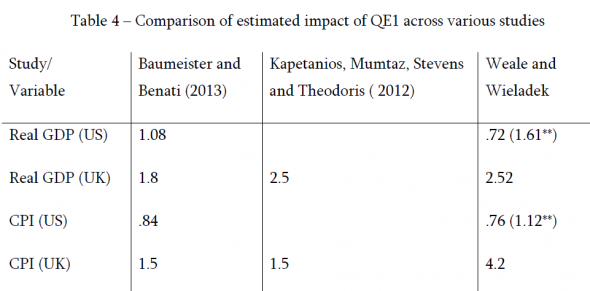First up, the Financial Times' Money Supply blog:
What did QE ever do for us?
More than five years after the start of the great QE experiment, agreement about what the asset buying scheme achieved is still thin on the ground. A new Bank of England paper from external MPC member Martin Weale released today tries to put a figure to how much QE boosted national output and inflation in the UK and the US. Its results are as follows:
“At the median, an asset purchase shock that results in an announcement worth 1% of nominal GDP, leads a rise of about .36% (.18%) of real GDP and .38% (.3%) in CPI in the US (UK). These findings are encouraging, because they suggest that asset purchases can be effective in stabilising output and prices”Here is how it compares to previous studies:
As you can see the results are broadly in line with previous papers in the case of all variables, except for UK inflation....MOREAnd from Real Time Economics:
Fed Bond-Buying Delivered ‘Significant’ Boost to U.S. Economy, IMF Researchers Say
How much of a punch did the Federal Reserve’s easy-money policies pack?
Former Fed Chairman Ben Bernanke famously quipped in his closing days that the problem with quantitative easing is that “it works in practice but it doesn’t work in theory.”
Not all central bankers and economists have agreed, spurring a debate over the effectiveness of the Fed’s policies. Part of the problem was that it was difficult to determine the impact of bond-buying on borrowing costs.
Some of the Fed’s own studies don’t find large gains from the central bank’s bond-buying programs. For example, San Francisco Fed researchers Vasco Curdia and Andrea Ferrero estimated the program that ran from late 2010 to early 2011 raised growth by just 0.13 percentage point. If accurate, all of the Fed’s bond programs together would have added less than a percentage point to economic output.
Others find more substantial effects. San Francisco Fed President John Williams in January estimated that $600 billion of Fed bond purchases lowered the yield on 10-year Treasuries by about 0.15 percentage point to 0.25 percentage point. That’s similar to the movement that would follow the Fed cutting short-term rates by 0.75 percentage point to a full percentage point – a relatively large rate cut, he said at the time.
In the paper published Friday, the duo backs Mr. Williams’s assessment....MORE
